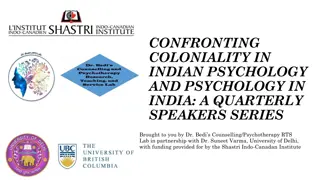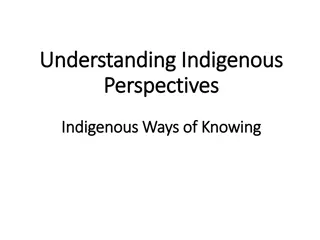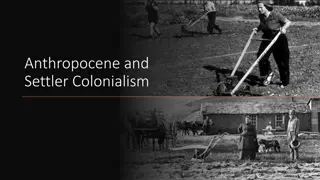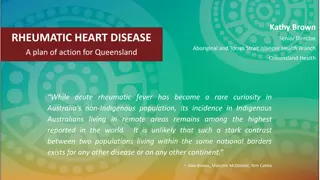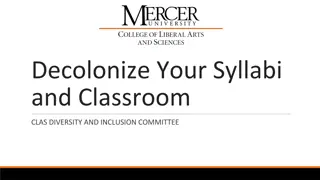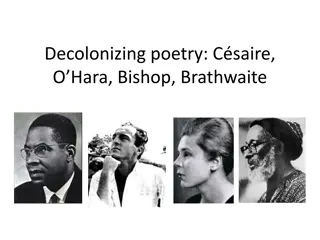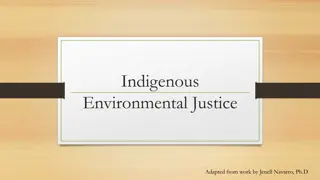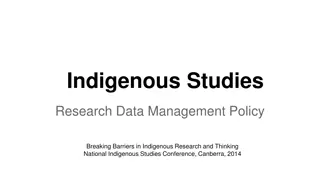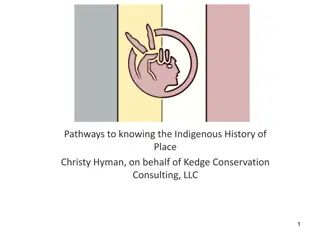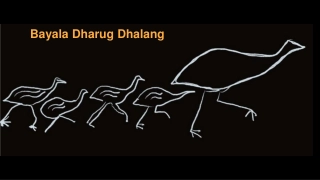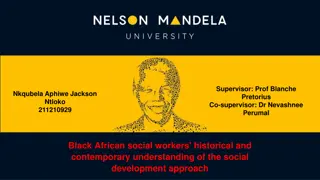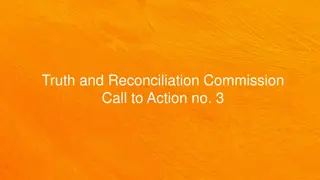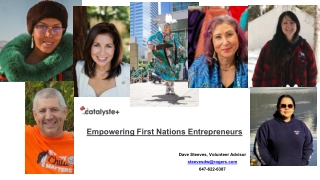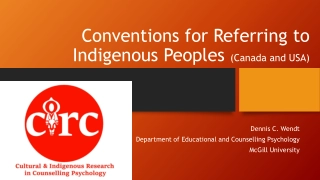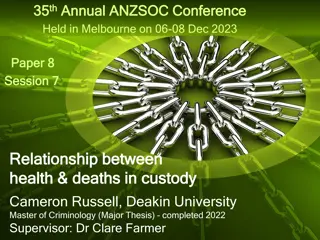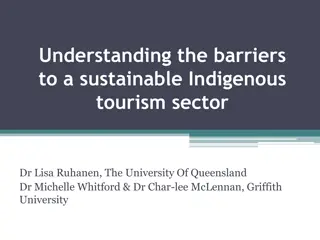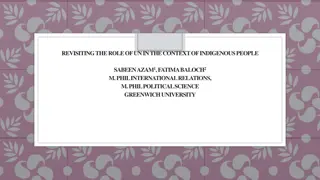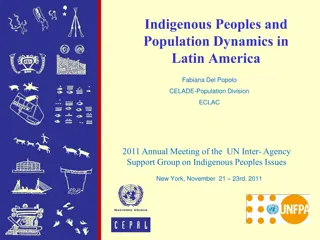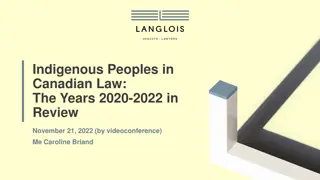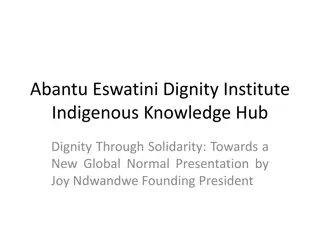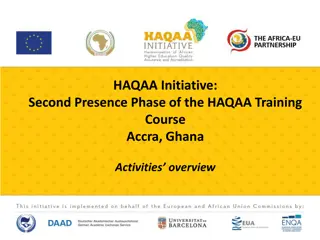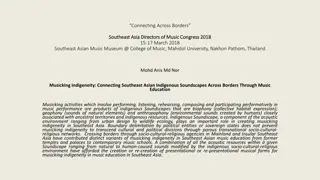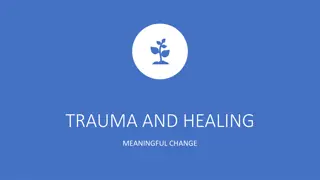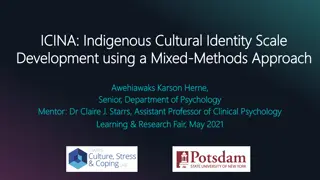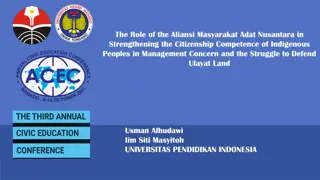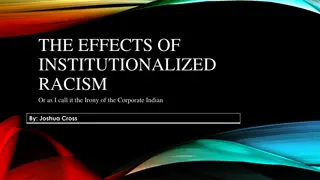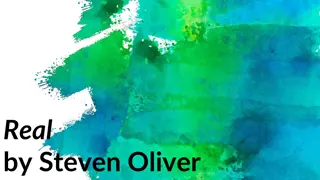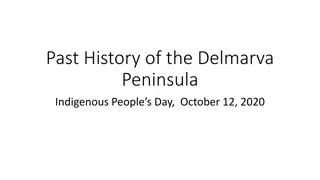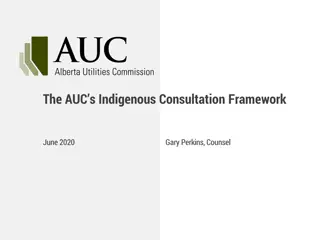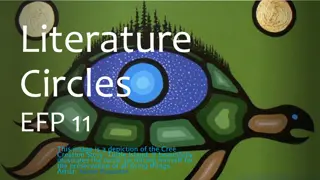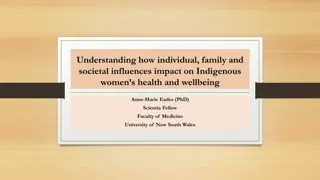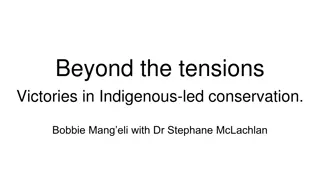Reviving African Indigenous Knowledge for Decolonizing Education
Mammo Muchie, a distinguished DPhil and research professor, will address the urgent need to revive African Indigenous Knowledge within the education system to decolonize it effectively. The conference will explore the key characteristics of Indigenous Knowledge, highlight the exemplary model of Imhotep, and propose transforming the African education curriculum by integrating STEM and IK. Recommendations will emphasize the importance of rethinking, reframing, and relearning to inclusively incorporate Indigenous Knowledge across all education levels in Africa.
Download Presentation

Please find below an Image/Link to download the presentation.
The content on the website is provided AS IS for your information and personal use only. It may not be sold, licensed, or shared on other websites without obtaining consent from the author. Download presentation by click this link. If you encounter any issues during the download, it is possible that the publisher has removed the file from their server.
E N D
Presentation Transcript
Title: Ways to Revive and Include the African Indigenous Knowledge to Decolonize the Education System in Africa International Internship University Monthly Conference by Mammo Muchie, DPhil: DST/NRF Rated Research Professor Tshwane University of Technology, Adjunct Professor, BDU, UoG & Haramaya University, Ethiopia, and Africa Centre of Excellence in Data Science, University of Rwanda;TMDC, Oxford University, U.K October 22,2022
Outline Inspiration What is Indigenous Knowledge What is Indigenous Knowledge Kkey Characteristics of Indigenous Knowledge Indigenous Knowledge The Model Imhotep: The Model Imhotep: The African Great Example of Indigenous Knowledge Excavating the Science and Technology roots from the African Origin https://www.afrilt.institute/ Transforming the African Education Curriculum STEM & IK as part of the Unity of Knowledge African Journal of Science, Technology, Innovation and Development(www.JSTID.com) Concluding Recommendations
Inspiration Time now to undertake Re Thinking thinking, Re-framing framing, Re-learning learning, Re-doing doing, Re- Transforming Transformation and Re-Peforming Performance and Re-forming Reformation, re-developing development and re-innovating innovation and reviving IK from the exclusion of the education system from kindergareten to tertiary university levels.
Inspiration Digital independence lesson to learn from China China cherishes its indigenous knowledge and independence having gone through colonialism like Africa The Chinese search engine Baidu is bigger than Google. Instead of YouTube, there is Youku. Instead of eBay, there is Taobao. Instead of Facebook, there is RenRen. Instead of Twitter, there is Weibo. There is VooV, not zoom Instead of YouTube, Facebook, and Twitter China has invented its own alternative tools . Africa still mainly copies and borrows digital technology.
Inspiration We need to create not states in Africa but African states ;not universities in Africa but African universities; not industries and businesses in Africa, but African industries and businesses; not NGOs and civil society in Africa but African NGOs and civil society; not to create 54 nations, but to create one African united nation by providing one African citizenship and one passport and one currency.
Inspiration There is also too much copying and mimicking by often ignoring indigenous and the African context in the production sphere of the innovation and development theory of knowledge . This must be corrected. Re-innovate innovation, re-develop development to re- conceptualize and re-theorize a unified, integrated innovation and an original sustainable African development theory There is a need to reconceptualise and re-frame both innovation and development by unifying the health, wellbeing, the social, economic, knowledge production value chain process to sustain both people and nature
Inspiration Africa is a treasure trove not only of Benin bronzes, coltan from the Democratic Republic of the Congo, and diamonds from Botswana. The real unmined gems are African concepts, ideas, values, ways of being and systems of knowledge and episteme. (Oyewumi, p. 4). When I refer to Africa, I mean the sum total of African cultures, as sedimented for millennia in philosophies, wisdoms, ways of knowing, ways of being and doing things as well as of relating to otherness (Olabiyi,Ya , 2008).
Inspiration Sustainable development has to be rooted in the culture, preserving local languages and integrating ancestral practices that are good for the environment. It has to resemble you and where you want your country to go. You can get there by being authentic and you can do that by teaching science in the local language, such as Wolof, a language of Senegal, Gambia and Mauritania. (Khady Sall, in Nature, 2022)
Inspiration The history of Africa, like the history of mankind as a whole, is really the story of an awakening. That story needs rewriting, for it has been considerably distorted by ignorance or self-interest. (Ki-Zerbo (1990, p. 1) The tragedy of the world is that those who have imagination have but slight experience and those who are experienced have feeble imaginations. Fools act on imagination without knowledge: pedants act on knowledge without imagination. Time to value the ignored indigenous knowledge to weld together imagination, STEM, and experience to build and create experienced learners with knowledge and imagination hybridity and synergy
Inspiration Science wars fought between those who wish to guard the epistemological purity of science The first salvo of the Science Wars was fired in 1992 with the publication of two popular works, one by an American physicist (Dreams of a Final Theory by Steven Weinberg) and the other by a British biologist (The Unnatural Nature of Science by Lewis Wolpert) In 1994, a biologist and a mathematician, Paul Gross and Norman Levitt, published the first full-length work devoted to these developments (Higher Superstition)
Inspiration The world is still divided by implicit or explicit classifications of inferiority and superiority Africans have not yet fully removed coloniality They still prefer to look and affirm each other by mimicking externality There is still failure to appreciate their full humanity by asserting their rich Africanity
Inspiration African identity continues to be subtracted by a degrading psychic dislocation Africans using external colonial presence by defining themselves with division Like Lusophone Francophone Anglo phone Ethnic phone Language phone Religion phone Gender phone And so on Africa is not a phone
Inspiration Africans must treat one another as one human family Practicing Ubuntu truly Building the African education system with IK & STEM with Ubuntu value really
Inspiration Not call some Africans as relatives and others as aliens Africa-philia must replace all- the divisive phones that turn the African one family as strangers Africa must overcome others continued demand to maintain their claims to superiority Africa can reject it by showing there is no justification to continue any form of inferiority By all Africans coming together showing the necessity to recognize full equality To build with the cherished rich African value of ubuntu one in all and all in one humanity
What is Indigenous Knowledge IK is very relevant and it is also called traditional and local knowledge IK is a product of cultures, traditions, values, beliefs, experience transmitted from generations Not universities and the academy Though it needs universities, Governments and academies to excavate, record, code and develop IK. Indigenous knowledge must no longer be ignored
IK & SK IK subordinate;SK dominant IK thinking style intuitive;SK analytical reductionist IK communication approach is mainly, oral, story telling, experiential SK is academic, positivist and objective IK explanation.. Spirtual, inexplicable, SK, scientific hypothesis, laws
Indigenous Knowledge is Getting Recognition knowldge recognised for social and economic development at the rural and community levels (e.g. World Bank, UNESCO, UNDP, UNIDO etc) The challenge is how to develop IK by organising a knowledge peace that leads to a positive sum game between IK and scientific knowldge, technology and engineering Keep the identity of IK even when promoting SK with STEM To bring out the transformative components from IK by integrating with STEMI-modern science, technology, engineering, mathematics and innovation
Key characteristics of Iindigenous Knowledge Four steps to define IK Socialisation Externalisation Combined innovation Internalisation or embedding
IK through Socialisation Promotes knowldge and experience exchange through engagement in social activitiese.g. informal meetings, living together, discussion, informal connections and other associations
IK Through Externalisation Transforms socialised tacit knowledge gained to explicit knowledge by creating concepts that can be understood and exchanged
IK Through Combined Innovation Transforms explicit knowledge into more systemic form making explicit knowldge to be communicated, diffused and systematised
IK through Internalisation or embedding Makes explict knowldge to be embedded into tacit knowledge, making it more complex and dynamical
STEM Originated in Africa All Non-Western sciences are pre-scientific (Lewis Wolpert) They could not have been any different he claims in his book the Unnatural Nature of Science Epistemological ethnocetrism advocated Greek seen as the cradle of western science Eurocentrism priveleged the Greek origin of western Science Martin Bernal wrote the book Black Athena acknowledging STEM from Africa o
A Great Example of Indigenous Knowledge from Africa Humanity originated from Africa, all knowledge also in every sphere was created in ancient Africa The case of Imhotep is something I strongly recommend all Africans must know Who is Imhotep? Imhotep was an ancient Egyptian architect, physician, astronomer, priest, politician, and scribe of the 27th century BCE. He was one of the most influential figures in the rise of Egyptian civilization as we know it and one of the first great scholars in human history. He was later deified as the god of medicine and wisdom.
Imhotep Means He Who Comes in Peace "The separation of the races is not a disease of colored people. It is a disease of white people. I do not intend to be quiet about it." Albert Einstein teaching a physics class at Lincoln University (HBCU in Pennsylvania) in 1946. The name Imhotep translates to He Who Comes in Peace , and was a polymath of high esteem, also being a poet, mathematician, and physician. The first Egyptian to be fully deified, he was later worshipped as a god of medicine after his death. There are around 200 cures and techniques attributed to him 2,200 years before Hippocrates, the father of medicine.
Contribution to a number of fields Imhotep is thought to be the author of the Edwin Smith Papyrus, which outlines a hundred medical terms and describes various injuries and their treatments. Imhotep was one of the first physicians to believe diseases occurred naturally and were not judgements from the gods. The papyrus contains detailed descriptions of physical conditions, with their treatments rooted in practical science. An inscription bearing his name was found on a statue of Djoser at the site of the pyramid, designating him as head of the sculptors and head of the seers. This was a sign of respect from Djoser, as previously only the names of the kings would be written on their tombs. Imhotep held many titles, starting life with little money or connections before working his way to the very top of Egyptian society.
Medicine and Architecture Not all of Egypt's most influential figures were pharaohs. Let us learn about the polymath Imhotep and see just how he impacted Ancient Egyptian Kehmet civilization. Imhotep was extremely educated, studying a number of disciplines, and was able to help orchestrate the growth of Kehmet. He is also said to have helped save it from famine and drought through his planning and ingenuity. While he contributed to a number of fields, there are two for which Imhotep is most remembered: medicine and architecture.
Know Ethiopia/Khmet is Linked to Imhotep If you are Christian, you go to Jerusalem If you are Judaic, you go to Israel If you are Muslim, you go to Mecca-Medina If you are Buddhist, you go to Asia If you are to know independence, you go to Ethiopia If you are to know who stretches her hand into God, you go for Ethiopia If you want to know the genius of geniuses, you go for Imhotep-the true African.
The Designer of the First Pyramid Imhotep, the man who designed the world s first pyramid, was the vizier. He was history s first known polymath. Imhotep was the Da Vinci of the ancient world, a professional scribe, physician, surgeon, astronomer, stonemason, and architect. He left behind a wealth of knowledge that has benefited generations of engineers and doctors in the Near East and throughout the world. His medical expertise was ground- breaking and well ahead of its time. Over two thousand years after his death, people declared him a god for his many contributions to Egyptian civilization and the progress of humanity.
The Giza Pyramids The Third Dynasty (2649-2575 BC) marked the beginning of a new era. With the reign of its second king, Djoser (Netjerykhet), the age of the pyramids began. Djoser s vizier (chief official) and architect, the famed Imhotep, began the experimentation in pyramid building which culminated in the magnificent Giza pyramids of the Fourth Dynasty. These pyramids provide evidence of the growing power and status of the king/pharaoh.
Pyramid complex at Sakkara The great Pyramid complex at Sakkara was built for Djoser. The design of the complex was unique. The design emphasized the Two Lands of Upper and Lower Egypt over which the king ruled. The 15 hectare sire was selected as it was on the edge of the western desert and overlooked the capital of Memphis.
Imhotep Comes from a Humble Background Imhotep came from a humble background. He was born in the village of Gebelein, south of Thebes, the ancient Egyptian capital. We know very little about his early life, other than that his father was an architect by the name of Kanofer. Imhotep lacked a royal upbringing but learned to read and write. He became a scribe and rose through the ranks to become the head priest of the Sun god Ra at Heliopolis, a city in Lower Egypt.
Imhotep with King Djoser Djoser was Egypt s Pharaoh during Imhotep s time. He was an ambitious man who did not want to be buried like his ancestors. Djoser requested Imhotep to design his new necropolis
Imhotep as Ras High Priest . Imhotep was a skilled engineer and an architect, besides being Ra s high priest. He was well-versed in the art of masonry. He used his knowledge to create the Pharaoh's vision of the world s first pyramid, the Step Pyramid of Saqqara also known as Djoser s Pyramid. Construction in Egypt prior to the pyramid was done with mud bricks. This was the first time they employed sophisticated masonry techniques to construct a structure entirely of stones.
The Designer of the Ancient Wonder. The Djoser s Pyramid was Imhotep s crowning architectural achievement. He may have designed an even larger pyramid, that of Pharaoh Shekhemkhet. Imhotep s architectural efforts enabled future generations of engineers to create the spectacular Great Pyramid of Giza, the oldest of the ancient world s seven wonders. True cities grew, agriculture became more sophisticated, architecture was more advanced, and at the heart of it all, was Imhotep.
The Father of Medicine Imhotep was Egypt s chief physician besides being the Pharaoh's right- hand man and a skilled builder. The multi-talented genius supervised the medical treatment of the workers who built the pyramid. Egyptians regard Imhotep as the father of medicine. Inscriptions on the walls of temples in Egypt show Imhotep taking care of sick people and getting rid of their illnesses. Over two thousand years before Hippocrates, Imhotep produced a comprehensive list of 90 medical terms regarding the human anatomy. He also identified 48 injuries of the human body. We know this medical dictionary as the Edwin Smith papyrus. The papyrus bears Edwin Smith s name, as he purchased it in 1862. It is the earliest medical encyclopedia ever discovered.
The original author of the Edwin Smith papyrus. The Edwin Smith papyrus is remarkable for its time, as it is the first document to describe the structures of our skull, brain, and spine. The treatment of spinal injuries mentioned in the papyrus would be far more advanced than anything produced before modern times. Egyptologists believe Imhotep was the original author of the Edwin Smith papyrus. He knew the location of various organs in the human body and understood how the circulatory system worked. According to the renowned oncologist and Pulitzer-winning author Dr. Siddhartha Mukherjee, the papyrus contains the first documented reference to cancer. Scientists analyzed the remains from six mummies and found evidence of individuals suffering from cancer. It appears the physicians tried treating some of the symptoms such as ulcers.
First Founder of School of Medicine Imhotep started a school of medicine in Thebes 2200 years before Hippocrates was born. He detected and cured nearly 200 ailments. 15 were abdominal, 11 were bladder related, 10 were rectum related, 29 concerning the eyes, and 18 involved skin, hair, and nails. Tuberculosis, gout, and arthritis are some diseases Imhotep successfully treated. He was not only a medical specialist, but he also conducted surgery and dentistry. Imhotep s discoveries were passed down through the generations, and that subsequent doctors could build on them. Imhotep s discoveries were passed down through the generations, and that subsequent doctors could build on them. Imhotep s discoveries were passed down through the generations, and that subsequent doctors could build on them
Imhotep Contribution to the Human Race Although he became a personality cult, there is no denying the immense contribution of Imhotep to the progress of the human race. Future pyramid makers built on his design to create the most remarkable feat of human engineering in the ancient world, the Great Pyramids of Giza. Phoenician, Greek, and Roman physicians inherited the medical knowledge of Imhotep from the Egyptians and built upon his methods. Imhotep s contributions to the world of medicine helped future generations of Egyptian physicians develop revolutionary inventions. One such discovery was the world s first recorded pregnancy test, which was 85% accurate.
Imhotep Fame Escalated Imhotep s fame increased in the years following his death because of his work healing ailments and defining human anatomy for future generations. Egyptians revered him as the creator of healing, and he made a Demi- god a hundred years after his death. But the peak craze about Imhotep was during the Greek rule in Egypt. Greeks compared him to Asklepios, the Greek god of medicine. 2000 years after his death, Egyptians declared Imhotep a god. He took the place of Nefterum in the triad of Memphis. The triad of Memphis comprises the god Ptah (god of creation), goddess Sekhmet (goddess of healing and wife of Ptah), and their son Nefertum.
The first Non-Royal to be Defied After his deification, people in Egypt recognized Imhotep as Ptah s son. He became one of the few non-royal Egyptians to be deified. The people of Egypt built temples in his honor at Memphis and Philae. Patients from all over the country flocked to his temples, hoping to find a cure for their illnesses. There was a deep conviction among them that if Imhotep blessed you, you will be disease-free. The cult of Imhotep lasted a thousand years until 550 A.D.
Priest of the Temple of Ptah It is believed Imhotep began as a priest in the temple of Ptah, his understanding of the will of the gods making him the most qualified person to build the pyramid which would house the Pharaoh s body for all eternity. This was a new venture: previous Pharaohs were buried in mastabas, rectangular structures with a flat roof which were built over the underground chambers where the dead were buried. The pyramid was constructed out of six masatabas built on top of one another. Imhotep changed the design to be square but had to redesign it to be rectangular. He also wanted to use stone instead of mud. This meant greater structural integrity and allowed him to build higher.
The Unique Pyramid Architecture There were 13 false doors cut into the stone with a 750m long trench dug into the ground. These were to discourage visitors, who would have to be told how to enter the complex. There were also mazes built into the underground chambers to protect Djoser s body. 40,000 stone vessels of different shapes and sizes were also found beneath the pyramid, inscribed with the names of previous rulers.
The Unique Pyramid Architecture The pyramid design was the tallest structure of its time and had a surrounding complex made up of a temple, courtyards, shrines, storerooms and living quarters for priests. Factoring in everything within the wall surrounding the complex, it was size of a city. These methods were used in later pyramids for other Pharaohs, but its is unknown whether Imhotep himself built these or if his designs were used by others emulating his style. This is unsurprising, as the design and construction of the step pyramid stands as one of the most important milestones in architecture and engineering in human history.
Multiple Imhotep Knowledge Contributions His unique role is the knowledge he contributed in many disciplines Astronomy Mathematics Engineering Science Politics Religion Good to do research and demonstrate the contributions He is the originator of the unity of Knowledge
Ancient Egypt was Kehmet, Ethiopia and Africa The ancient Egyptian civilization was the first of the recorded great world civilizations. Little is known about the prehistoric societies that came before Egypt but it is assumed that they were steeped in superstition and that their ability to treat disease was primitive at best and possibly non-existent. But Ancient Egypt was Kehmet, Ethiopia and Africa Humanity , Science and Civilization originated from Africa Imhotep was African Let us celebrate the origin of humanity: Know that science, knowledge, innovation, medicine, astronomy, engineering, technology, mathematics architecture and philosophy originated from Africa
Indigenous Language : ONE AFRICA, 2000+ LANGUAGES! African Indigenous Language Technology Institute founded A world where Africans can communicate and access information through the internet, in their own indigenous languages.
Indigenous language Enable Sustainable African solution to African multilingualism and diversity for development issues Advance African Indigenous Language Technology & Applications knowledge in the global knowledge space, Build African capacity for African Indigenous Language Technology & Applications Education, Research, Innovation, and Entrepreneurship Enable ethical research and innovation, informed and driven by diversity-aware unitary data about language, knowledge, and human behavior, as a step towards a better and more inclusive society
African Contributions to Science:Examples in Physics, Chemistry, Engineering and Astronomy Civilisation, astronomy, science, mathematics and philosophy originated from Africa Physics/Mechanics/Engineering The level, the screw, Archimedes principle , C.A. Diop (nuclear physics), Abdou Moumouni Dioffo (Solar physicist), Edouard Adjanohoun (Botanist) Chemistry/Metallurgy/Ceramics Iron age (Southern Africa) ~ 2600 BC-1500 BC, Metallurgy of Iron (steel) ~ 900 BC, Benin Bronze, Indigenous/artisanal mining (Chirikure, 2009) Medicine Imhotep (Father of Medicine), Peseshet (first woman surgeon, 4th dynasty), Charles Drew (blood transfusions) Astronomy Ancient Egypt (solar calendar), Dogon (Sirius B), Benjamin Banneker (surveyor, astronomer)
Some Examples from Africa: Mathematics Proto-maths: Lebombo bone (S.A./Swaziland) ~35,000 B.C.; Ishango bone (Congo)~25,000 B.C. Ancient Egypt: Ahmose (Rhind) mathematical papyrus ( )~1650 BC, Moscow papyrus Sona Geometry (Angola) symmetrical, monolinear. Basis for new mathematical ideas like mirror curves and various classes of matrices (cycle, cylinder, helix)- (Gerdes, 2009) African fractals (West and Central Africa) repeating geometric patterns at various scales used in textiles, paintings, sculpture, cosmologies, architecture, town planning. Fractals are the basis of the worldwide web (Eglash, Odumosu, 2005) Binary logic in Yoruba culture for both computation and metaphysics (Segla, 2010)


